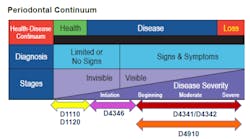Thursday Troubleshooter: Is this dental code ethical and legal, or is it fraud?
Problems! Who doesn't have them? If you have a problem or concern in your dental office position, you might be too close to the situation to solve it yourself. Share your concerns with Team Troubleshooter. The experts will examine your issues and provide guidance. Send your questions to [email protected].
QUESTION: If a patient has moderate calculus and bleeding and pocketing of various 4 mm pockets, and the patient has not had his or her teeth cleaned in five years, is it ethical and legal to code for D1110?
ANSWER FROM PATTI DiGANGI, founder of DentalCodeology:
I assume you mean your office is using D1110 accurately per CDT coding guidelines? A dentist’s clinical decisions determine what services (procedures) are delivered to patients. The full CDT code entry, as published in the CDT manual, must be considered when determining which dental procedure code should be used to document services provided.
Which evaluation was completed to determine treatment? Though this is a patient of record, it has been five years since the person has visited the practice. The D0120 periodic oral evaluation, established patient, might not be the most accurate.
The D0150 comprehensive oral evaluation, new or established patient, might be more accurate. Part of its descriptor states, “This applies to new patients, established patients . . . who have been absent from active treatment for three or more years.” It also might be more accurate to use D0180 comprehensive periodontal evaluation, new or established patient, because part of that description states, “This procedure is indicated for patients showing signs or symptoms of periodontal disease . . .” What you describe sounds like there are signs of perio.
What must be considered with any of these evaluations are the requirements of those evaluation codes. It is often misunderstood that there are no exam codes in CDT. The introduction of the D0100–D0999 clinical oral evaluations sections states, “. . . however, the evaluation, which includes a diagnosis and treatment planning, is the responsibility of the dentist.” This means there needs to be a written diagnosis for whatever evaluation is completed. In case after case on recordkeeping, the courts have decided that if it isn’t written, it wasn’t done. What is the documented diagnosis by the dentist for this treatment selection?
The next question is, what are the parameters for treatment under D1110 prophylaxis treatment code? We need to look at the newer (2017) D4346 scaling in the presence of generalized moderate to severe gingival inflammation, full mouth after oral evaluation. This code puts the difference into sharp focus.
In the past, before there was clinical attachment loss (CAL), all gingival disease was coded D1110 prophylaxis. This is no longer true. We as clinicians have long known that gingival disease is not all the same. With more information daily on the oral-systemic health connection, it is very important to recognize and treat gingival disease before CAL. Figure 1 shows the periodontal health continuum and layers of the CDT treatment codes.
The question again becomes, what is the diagnosis? I have previously written in this column about the importance of a documented diagnosis. Dental practices and practitioners are required to use the code that most accurately describes the treatment. It can be considered fraud to use or change a code to increase or enhance reimbursement.
This case could be a prime example. With the brief description given, there is not enough information to make a diagnosis. It does sound like it could possibly be that gingival inflammation case, but we can’t know without radiographic images to determine bone height. Posterior bitewing radiographs are inadequate because there is no view of the anterior area. If there is greater than 30% inflammation in the absence of periodontitis, then the treatment is accurately coded as D4346. If you use D1110 because you believe there is better coverage, then the office is under coding. This goes over the fraud line.
Fraud by ignorance or accident is still fraud. Health care fraud has been described by one scholar as an intentional attempt to wrongfully collect money relating to medical services, while health care abuse has been described as actions that are inconsistent with acceptable business and medical practices.
Intentional inaccurate coding can also lead to legal issues with state practice acts and laws. Here is an example in the Illinois Practice Act. Many states have similar clauses. It states: “Gross or repeated irregularities in billing for services rendered to a patient. For purposes of this paragraph, ‘irregularities in billing’ shall include a) reporting excessive charges for the purpose of obtaining a total payment in excess of that usually received by the dentist for services rendered, b) reporting charges for services not rendered, and c) incorrectly reporting services rendered for the purpose of obtaining payment not earned.
The dental profession holds a special position of trust within society. As a consequence, society affords the profession certain privileges that are not available to members of the public-at-large. In return, the profession makes a commitment that its members will adhere to high ethical standards of conduct. Both the American Dental Association and the American Dental Hygienists’ Association have a code of ethics.
RECENT TROUBLESHOOTERS
How many people are needed to run the front office smoothly?
The dilemma of 2 primary insurances, often in a divorce situation
What to do about dentist who underdiagnoses?
Don't be shy! If YOU have a tough issue in your dental office that you would like address, send it to mkaiser@endeavorb2b for the experts to answer. Remember, you'll be helping others who share the same issue. Responses will come from various dental consultants, as well as other experts in the areas of human resources, coding, front office management, and much more. These people will assisting dental professionals with their various issues on DentistryIQ because they're very familiar with the tough challenges day-to-day practice can bring. All inquiries will be answered anonymously each Thursday here on DIQ.
About the Author
Team Troubleshooter
This column features questions from everyday people who work in dental practices, who have issues they would like addressed by the experts. It no longer runs regularly, but the questions sent in the past still apply to dental practices today. Search "Troubleshooter" on DentistryIQ to read more.

